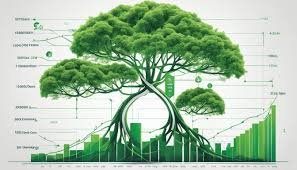As we move further into 2024, the rise of green investments is reshaping the global economy in profound ways. Sustainable finance, which includes investments in environmentally friendly projects and technologies, is becoming a major driver of economic growth and transformation. This shift is not just a trend but a fundamental change in how capital is allocated, reflecting a growing awareness of environmental issues and the need for sustainable development. Here’s a closer look at how green investments are impacting the global economy.
1. Growth of Green Investment Markets
The green investment market has seen significant expansion over the past few years. According to the Global Sustainable Investment Alliance (GSIA), sustainable investment assets have grown to over $35 trillion globally, representing a substantial portion of total assets under management. This growth is driven by increased investor demand for environmentally responsible options and regulatory support for sustainable finance.
Countries and financial institutions are increasingly integrating environmental, social, and governance (ESG) criteria into their investment strategies. For instance, the European Union’s Green Deal and Sustainable Finance Disclosure Regulation (SFDR) are setting high standards for transparency and accountability in green investments. Similarly, the United States has seen the rise of ESG-focused investment funds and green bonds, which have become popular among both institutional and retail investors.
This expansion of green investment markets is leading to the development of new financial products and services, such as green bonds, climate bonds, and sustainability-linked loans. These instruments are designed to fund projects that contribute to environmental sustainability, such as renewable energy, energy efficiency, and sustainable agriculture. The success of these financial products is helping to channel capital into projects that address climate change and support sustainable development goals.
2. Economic Benefits of Sustainable Finance
Green investments are generating significant economic benefits beyond their environmental impact. One of the primary advantages is the creation of jobs in green industries. According to the International Labour Organization (ILO), the transition to a low-carbon economy could create up to 24 million jobs globally by 2030. This includes roles in renewable energy sectors, such as solar and wind power, as well as in energy efficiency and sustainable transportation.
Moreover, sustainable finance is driving innovation and technological advancement. Investment in clean technologies and green infrastructure is accelerating the development of new solutions to environmental challenges. For example, advancements in battery technology and renewable energy systems are improving the efficiency and affordability of clean energy. This, in turn, is making green technologies more competitive with traditional energy sources and encouraging further investment in sustainable innovations.
Green investments also contribute to economic stability and resilience. By focusing on sustainability, businesses and governments can reduce their exposure to environmental risks and enhance their long-term financial stability. For instance, investments in climate-resilient infrastructure can help communities withstand the impacts of extreme weather events, while sustainable agricultural practices can improve food security and reduce supply chain disruptions.
3. Challenges and Future Outlook
Despite the positive impacts, green investments face several challenges that need to be addressed to ensure continued progress. One of the main issues is the lack of standardized metrics and reporting frameworks for evaluating the environmental impact of investments. While various guidelines and standards exist, such as the Global Reporting Initiative (GRI) and the Task Force on Climate-related Financial Disclosures (TCFD), there is still a need for greater consistency and transparency in reporting practices.
Additionally, the greenwashing phenomenon poses a risk to the credibility of sustainable finance. Greenwashing occurs when companies or investment funds make misleading claims about their environmental impact to attract investors. To combat this, regulatory bodies and industry groups are working to develop stricter guidelines and verification processes to ensure that green investments deliver genuine environmental benefits.
Looking ahead, the future of green investments appears promising. As awareness of environmental issues continues to grow and regulatory frameworks become more robust, the green investment market is expected to expand further. Innovations in financial products, coupled with increasing investor interest, will likely drive the continued evolution of sustainable finance. The integration of green investments into mainstream financial practices will play a crucial role in achieving global sustainability goals and ensuring a resilient and prosperous future for the global economy.
In conclusion, green investments are significantly reshaping the global economy by driving market growth, creating economic benefits, and fostering innovation. While challenges remain, the trajectory of sustainable finance points towards a future where environmental considerations are integral to financial decision-making, paving the way for a more sustainable and equitable world.
